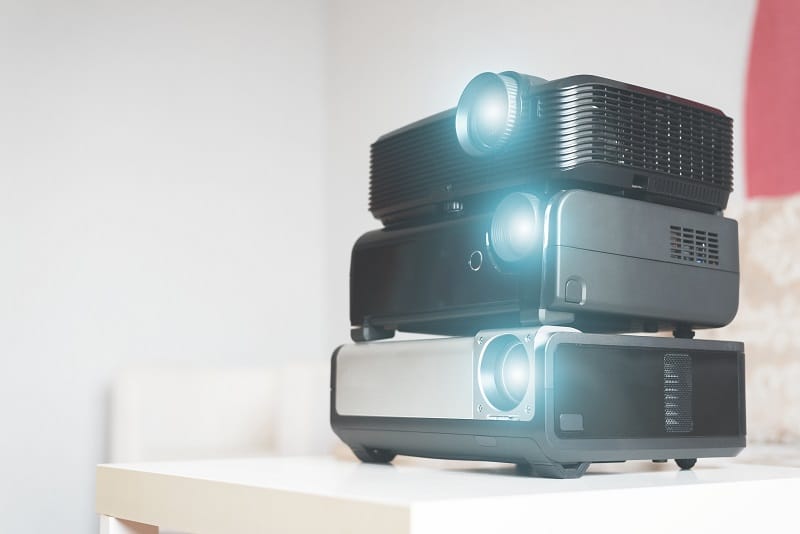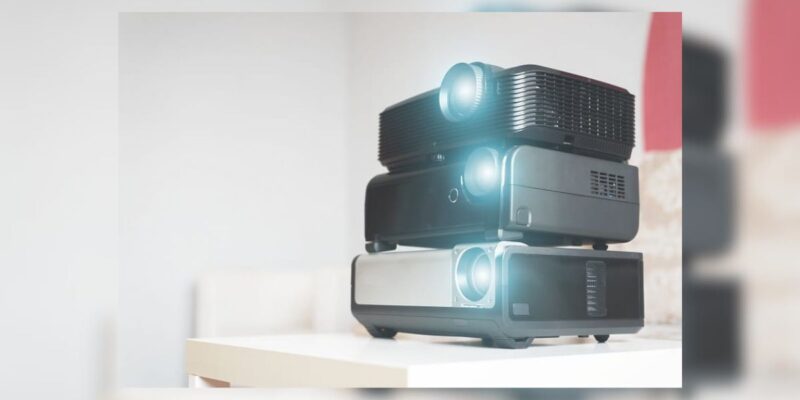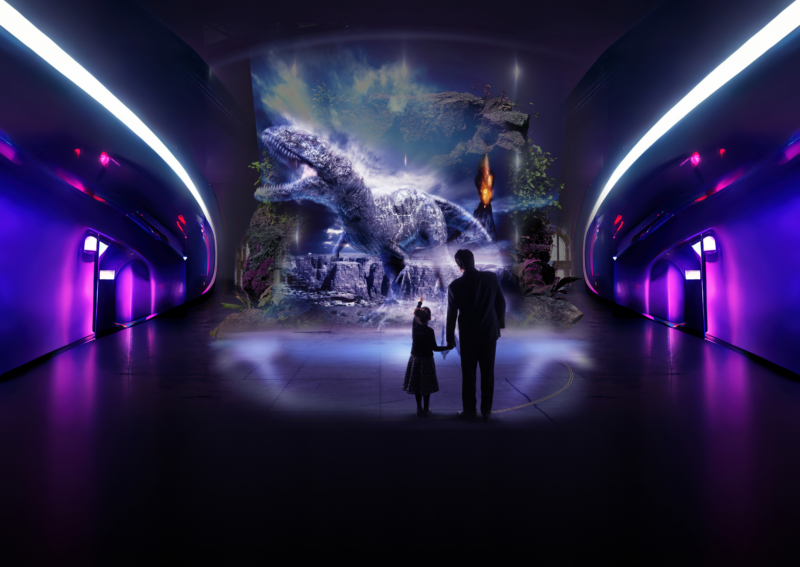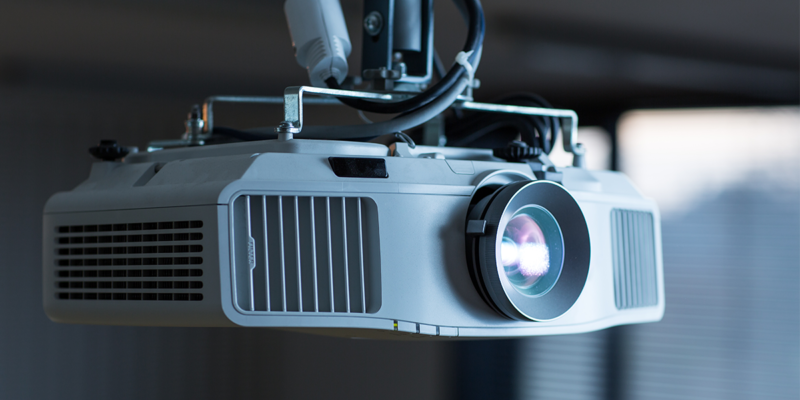Picking the Proper Projector
It’s 2024 and despite the proliferation of microLED and the high availability of low bezel LCD screens, projectors are still alive and well in the AV industry.
Rumors of their death have been circulated for years, yet, just like they say in Monty Python, they’re “not dead yet!”
Interestingly enough, I find that specifying the proper projector is still somewhat of a mystery for a lot of AV professionals, so I thought I’d give a few tips to help demystify this often misunderstood AV staple.

Projector brightness is often misunderstood. Is a 15,000-lumen projector bright? It depends on how large of an image you are creating. You first need to determine your image size, and then divide the total brightness by the screen area in order to get a feel for how bright the image will actually be.
CAUTION: AV MATH AHEAD
Let’s pick an east size for reference: 16 feet wide by 9 feet tall which equates to a 220″ diagonal.
The screen area is 16 feet x 9 feet or 144 square feet. We’ll use this as our basis of discussion throughout, so return to it for reference if needed.
So with 144 square feet of surface to illuminate, how much much brightness do we need?
Tip 1: Start at 100 lumens per square foot
In this example, starting at 100 lumens per square foot yields:
100 lumens per sq/foot x 144 sq/feet = 14,400 lumens.
Why do we start at 100 lumens per foot?
In AV we love to confuse people by taking in different terms for different technologies. Projectors are rated by total brightness in lumens and screens like LCD and dvLED are rated in nits while our ambient light is rated in lux.
Are lux and nits related to lumens? The answer is yes.
Lux is a measurement of lumens per square meter.
Nits are a measurement of lux divided by pi.
Most LCD screens in our homes are around 350 nits. We typically find this an acceptable brightness for basic indoor viewing, so let’s use this as a baseline.
Per above, nits X pi equals lux, so 350 nits is equivalent to 1099 lux.
1099 lux or lumens per square meter, divided by 10.76 square feet per square meter equals just over 100 lumens per square foot.
Starting at 100 lumens per square foot gets you a brightness equivalent to a standard LCD display.
Tip 2: Look at lens light loss specs
Most high-end projectors have a choice of lenses with different throw ratios. One of the often overlooked specifications is the light loss of the lens. Some of these lenses can decrease light output by 30% while others may have negligible loss.
Once you know the throw ratio of the lens you need, check the lens specifications for light loss and adjust your projector brightness accordingly. In this case, lets say the light loss is 10%, so we will increase our desired projector brightness from 14,400 lumens by 10% or from 1,440 lumens to 15,840 lumens.
Tip 3: Adjust for headroom
Most laser projectors will last longer if not run at 100% brightness. If you want to build in some extra projector life, you may want to lower the brightness by 10-20%.
Again in this case, let’s say we’re going to run the projector at 90%, then we’d add 10% more to the brightness spec to maintain the 14,400 on the screen.
Our 15,840 lumen projector is now up to 17,424 lumens.
Tip 4: Adjust for contrast ratio
If you take one thing away from this post, remember that you can’t project black. “Black” will be whatever color the projection surface is with the lights at the level you intend to keep them while projecting.
Ambient light is measured in lux, and 10 lux is fairly low light in a space.
Assuming 10 lux on the screen, and 144 lumens per foot or 1099 lux from the projector , the contrast ratio of the image will be 1109 lux (projected light + ambient light on surface) divided by 10 lux (ambient light on surface) or 110.9 to 1.
In my experience, contrast ratios of 100:1 in a projected environment are received very well. For some environments that are less critical, the lower threshold in my opinion is about 30:1. Below that, and things start to look abysmal,
Now you’re saying, “Mark, but the projector says it has a contrast ratio of 1000:1?”
Ignore that almost completely. The contrast ratio stated by the manufacturer is the difference between pure white at full brightness and video black. It has little bearing on the contrast ratio being achieved in the actual environment you are designing.
What you need to do is take a light measurement from the screen surface in the space with the lights at the level the client intends to use the space.
Let’s say they need the lights higher for writing and making notes, up to 50 lux. Well that same projector, at 1099 lux, considering the 50 lux on the screen surface, now yields a 23:1 contrast ratio.
All of a sudden you need more brightness to achieve acceptable contrast. Doubling the projector to 35,000 lumens gets you back to about a 45:1 contrast ratio.
Tip 5: Assess resolution
If you’re comparing your projection system to a DVLED based screen, you’ll notice another idiosyncrasy. DVLED is described in pixel density (pixels per square meter) while projectors utilize total resolution.
Total resolution can be misleading however, as that resolution, just like the light, is spread across the size of the image. A larger image then yields lower pixel density even though the projector is the same resolution.
In our example, we have a 220″ diagonal screen. If you’re using a 4K projector, then the pixel density is 3840 x 2160 or 8,294,400 pixels DVIDED by the square meters of the screen surface (in this case 144 square feet is equal to 13.38 square meters) and the pixel density would be around 620,000 pixels per square meter.
This means a 220″ diagonal projected image produced by a 4K projector has about the same pixel density as a 1.2mm DVLED screen.
These of course aren’t the only considerations, and there are differences between native resolution, pixel shifting, 3 chip and single chip DLP, LCD, SXRD/LCoS, laser phosphor/RGB laser/lamp projectors as well. And different screen materials can reduce/add gain or reduce ambient light reflection as well.
However, I hope these tips are helpful in assessing how to specify the proper projector for a project or at least how to evaluate projection vs another display technology.
As you can see in our example, just by adjusting for 10% light loss on the lens, 10% headroom on the brightness, and the actual light in the room, we went from a 14,400 lumen model to a 35,000 lumen model to achieve an acceptable result.
This may make the case for going to LCD or DVLED strong, or, on the other end of the spectrum, it may help you justify why projection is a better value for the client. Of course my final piece of advice is this:
Nothing beats an on-site demo or a shootout.
If you’re wanting to set the proper expectations, a demo does it every time.




